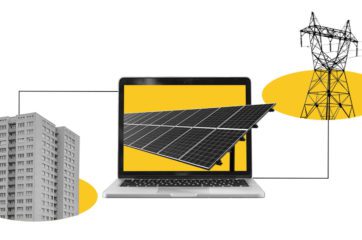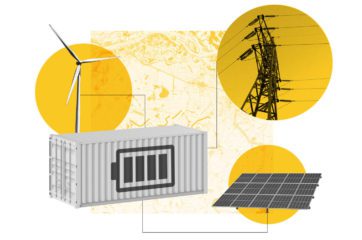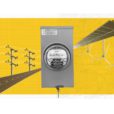Climate XChange’s Dashboard Digest is a deep dive on each of the policies that we track in the State Climate Policy Dashboard and an exploration of how these policies can interact with one another to form a robust policy landscape. The series is intended to serve as a resource to state policy actors who are seeking to increase their understanding of climate policies, learn from experts in each policy area, and view examples of states that have passed model policies. We’re beginning our series by exploring renewable energy and energy storage policies.
Electricity production contributed to 25 percent of the total greenhouse gas emissions for the United States in 2020. According to the Department of Energy, actual greenhouse gas emissions from the electricity sector were less than half of what was predicted in 2005, largely due to the increased adoption of renewable energy and more efficient end use of that power. Still, the electricity sector has a long way to go before reaching net-zero emissions in a timely manner – one that maintains our country’s pledge to the rest of the world to help keep overall warming under two degrees Celcius.
In recent years, states have led the way on electricity policy by passing 100 percent renewable energy mandates, creating clean energy plans, and drafting other legislation that supports resilient and green electricity markets. The IPCC Report on mitigation strategies found that the cost of low emission technologies has fallen consistently since 2010, and we are seeing burgeoning renewable energy markets in states across the country.
The United States’ pledge, known as a Nationally Determined Contribution, sets an economy-wide target of reducing the country’s net greenhouse gas emissions by 50-52 percent below 2005 levels by 2030.
In the Renewables and Energy Storage policy category, we will examine each of the policies we track while considering how foundational policies can support subsequent ones – and ultimately help create a mature renewable energy market.
Visit the Dashboard to see policies adopted in your state.
Strong Renewable Markets Have Strong Foundations
In the late 2000’s, the United States, like the rest of the world, saw an increase in solar technology in its energy portfolios. Louisiana, a state not known for its renewable market today, was in a position to be a leader in this fast growing solar market. At the time, Louisiana had strong tax incentives for solar installations, offered low interest loans, and the state gets a lot of sunlight (it’s in the top 20 states for peak sun hours). Based on all of these factors, it would’ve been natural to assume that adoption of solar technologies would increase. But by 2010, the state had only installed 0.2 megawatts (MW) of solar capacity, one of the lowest in the country. This begs the question: why did a state with a net metering policy, helpful financial incentives, and ample solar resources have such slow adoption of solar technology?
While the answer may not be simple, one contributing factor could be a lack of foundational policies that would unlock the ones that the state had in place. Louisiana was entirely lacking interconnection standards — rules for how a customer can connect solar panels to the energy grid. Without this energy infrastructure policy, the state’s financial incentives were outweighed by the difficulty that a customer would have in actually installing their solar systems. Like a staircase with steps missing at the bottom, Louisiana made it theoretically possible to implement solar power, but there were policies missing that would have made it practical.
This concept of interconnecting renewable energy policies is known as policy stacking. Climate XChange spoke to Trina Hoffer and Carlyn Petrella from the Center for the New Energy Economy about how states can utilize this framework to implement renewable energy policies in the most effective order.
Read More: Strategic Sequencing for State Distributed PV Policies: A Quantitative Analysis of Policy Impacts and Interactions (NREL, 2012)
Policy Stacking: What Is It?
Policy stacking is a framework developed in 2012 by the National Renewable Energy Laboratory (NREL). Assuming a goal of market saturation for renewable energy technology, the framework suggests that policies are most effective when they’re implemented in a particular order. Though we focus on the electricity sector, the stacking framework can also be applied to buildings and transportation policies to achieve similar results.
Petrella says that it’s vital to have foundational policies if a state intends to increase its generation of renewable energy, like Louisiana did. “If you can’t connect [distributed renewables] to the grid and have it flow, it’s not going to function. And then people get frustrated and say wind [power] doesn’t work.”
The policy stacking framework sorts policies into three tiers, each one pertaining to a goal for the development of a state’s renewable energy market:
Distributed generation is electricity that is produced at or near the site where it will be used. Examples include rooftop solar, small-scale wind, and combined heat and power systems.
Tier One – Market Preparation. Policies in this category are those that make it possible for people to use renewable technologies. They reduce or remove regulatory, legal, or physical barriers to renewable energy development. These policies create conditions that enable adoption of renewable technologies, but don’t necessarily encourage it on their own. These policies include interconnection standards and net metering policy.
Tier One Policies
- Interconnection
- Net Metering
- Utility Green Power Option
- Customer Data Access
Tier Two – Market Creation. These policies attempt to actually create demand for renewable technologies by establishing a market in the state. They also signal long-term commitment to renewable energy from the government. When a state passes a mandate for energy procurement, it signals to private investors that the market will have long-term potential and can encourage investments. Policies in this category include Renewable Portfolio Standards and carve-outs for distributed energy and solar generation.
Tier Two Policies
-
Renewable Portfolio Standards
-
Distributed Generation/Solar Carve-out
-
Energy Storage Standard
-
Grid Modernization Plan
-
State Energy Plan
Tier Three – Market Expansion. The policies in this final category provide financial incentives to expand the renewable market that’s already in place. Grants, tax incentives, and financing opportunities can make it more attractive to encourage investment in niches of the market that aren’t addressed by normal economic activity. These policies include aggregate net metering and shared renewable standards. “Once you’ve kick started the market, you can add financial incentive policies on top of that to push it along and get additional uptake,” Hoffer told Climate XChange.
Tier Three Policies
- Shared Renewables
- Aggregate Net Metering
- Renewable Standard Offer
- Solar Incentives
- Third-Party Financing
How Using Policy Stacking Can Unlock Potential
The stacking framework can be used by state actors to implement renewable energy policies that build on one another and ensure that each one is as effective as possible. It creates a standard of best practices that is applicable across the country, regardless of the historical or economic landscape of the state.
Hoffer says that policy stacking can be used retrospectively to analyze a state’s successes or failures, but it can also be used for long-term policy development. She adds that states that have passed their policies out of order based on stacking tiers don’t necessarily need to start from square one. “It’s more about asking, where are the gaps? Instead of rebuilding the house, how do we shore up the foundation? Or how do we add an addition?”
Petrella emphasized that the quality of foundational policies shouldn’t be overlooked in the pursuit of passing policies in all three stacking tiers. “It’s important to have good policy in place, strong, robust policy, because then if it works, you can gain public favor.” Proving the benefits of any climate policy to the public is essential to gaining trust, which will be helpful in building upon those policies. Additionally, Petrella notes that it can be dangerous to pass policies just to cover each tier if the state doesn’t consider all of the implications and externalities of that policy. Plus, she says, “It’s far harder to amend legislation or fix it and you can cause some real problems even with the best intentions.”
In a report from 2012, the National Renewable Energy Laboratory found evidence supporting their policy stacking theory. The report, which focused on customer-sited solar capacity, found that higher quality market preparation policies strengthened the impact of a state’s Renewable Portfolio Standard. Of states that enacted an RPS during the years studied, NREL found a correlation between higher quality interconnection and net metering standards and annual solar capacity additions.
To better understand the effect of stacking on a state’s clean energy economy, we’re diving deeper into two states’ policy approaches.
Oregon: Successful Policy Stacking
Oregon’s renewable energy history provides an example of successfully stacked policies. In 1999, a time when many states were restructuring their electricity markets, Oregon passed standards for interconnection and net metering policy, which dictated how customers could connect to the energy grid and be credited for energy they produced. These Tier One policies set the stage for renewable energy markets to have the ability to mature at a later time. In 2007, the state increased the capacity of its net metering policy, further removing barriers to larger customer-owned energy systems.
Oregon passed a Renewable Portfolio Standard in 2007, and then in 2016 the state increased the goal to procure half of the state’s energy from renewable sources by 2040. Recent legislation in 2021 built upon this mandate by requiring utilities to reduce greenhouse gas emissions by 100 percent by 2040. In 2015, Oregon added a Solar Carve-Out policy to signal the state’s long-term commitment to solar energy. These mandates essentially create a market for renewables in the state, and fall under Tier Two.
Oregon created a shared renewables policy in 2016 to allow multiple customers to participate in a shared solar generation system. This Tier Three policy is an incentive to attract additional investment in solar, a sector of the renewable market that requires further help from the state.
There are certainly other contributing factors that have led to the state of Oregon’s current renewable energy market, but policy stacking can help explain the effectiveness of each policy. From laying a foundation for the market to creating tools that encourage investment, this suite of policies contributed to almost 70 percent of the state’s energy being generated by renewable sources in 2020, including significant increases in utility-scale solar generation.
Oregon’s HB 2021 tasked electric utilities with reducing their greenhouse gas emissions by 100 percent of “baseline emissions levels” by 2040, with intermediate targets. Baseline levels are a utility’s average annual emissions for the years 2010, 2011, and 2012. Oregon has required electricity suppliers to report this since 2010.
Massachusetts: Market Creation without Preparation
The expansion of Massachusetts’ renewable energy market provides an example for the effectiveness of filling in policy gaps and strengthening foundational policies. After passing policies out of stacking order in the 1990s, the state didn’t experience growth in the solar sector until strengthening its Tier One policies in 2008. While the growth of Massachusetts’ solar market cannot be fully attributed to strengthening Tier One policies, this correlation supports the benefits to the policy stacking framework.
In order to satisfy a federal law from 1978, Massachusetts’ Department of Public Utilities adopted net metering standards in 1982. Qualifying energy systems were limited to 30 kilowatts and credits had to be used in the month they were generated.
In 1997, the state created the Renewable Energy Trust Fund, which was funded by ratepayers of electric distribution companies and provided solar rebates. This Tier Three policy was designed to incentivize adoption of solar technology which was also supported by a limited net metering policy from the early 1980s.
Also in 1997, Massachusetts enacted a Renewable Portfolio Standard which signaled long-term state commitment to the renewable energy market. This Tier Two policy is important for a state to create demand for renewable energy technology.
But according to data from the Interstate Renewable Energy Council, by 2003, Massachusetts had less than one megawatt of installed solar capacity. Although the state had some form of net metering, created a renewables market, and provided solar incentives, actual adoption of solar technology lagged for several more years.
By April, 2007, there were still just three MW of solar capacity in the state when then Governor Deval Patrick announced a goal of 250 MW by 2017. In 2008, the legislature passed sweeping climate policies through the Global Warming Solutions Act, Green Communities Act and Green Jobs Act. The Green Communities Act improved the state’s net metering policy by expanding eligible systems to two MW and allowing credits to carry over month-to-month and transfer to other customers. During this time, the state also saw major improvements in interconnection standards, facilitating the connection of distributed solar to the energy grid.
This means that major growth in the solar market didn’t begin to occur until after the state updated or adopted foundational Tier One electricity policies, even though they had already created a renewable market and had some financial incentives. Massachusetts increased its solar target after reaching its 250 MW goal four years early and was ranked tenth in the nation for cumulative solar capacity in 2021.
Read More: History of Solar in Massachusetts
What We're Covering Next
In our upcoming articles, we will use the stacking framework to examine individual Renewables and Energy Storage policies. Through the lens of policy stacking, the articles will feature a deep dive into the details of each policy, its key components, and examples of model policies that states have passed. The policies for this category include:
Net Metering and Aggregate Net Metering
These policies allow a customer to be credited for selling energy they generate back to the utility company and establish rules for the transactions.
Energy Storage Standard
These standards ensure that energy storage technologies are easily integrated into the grid and create a market that encourages private and public investments.
Renewable Portfolio Standard
Renewable Portfolio Standards set goals for electric utilities to obtain a certain percentage of their electricity sales from renewable sources by a specific date.
Distributed Generation/Solar Carve-Out
This policy, which is often incorporated into a Renewable Portfolio Standard, identifies specific technologies that must be utilized to meet a state’s overall renewable energy targets. Often the purpose of this policy is to advance distributed energy resources that may have higher costs and are not addressed by typical market forces.
Shared Renewables
This policy incentivizes the adoption of renewable technologies by allowing customers to subscribe to a generation facility, also addressing physical and financial barriers to renewable ownership.
In the meantime, you can visit the State Climate Policy Dashboard to learn more about electricity policies in your state.
About CNEE: The Center for the New Energy Economy was founded in 2011 as a department at Colorado State University by Colorado’s 41st Governor, Bill Ritter Jr. The Center convenes and facilitates dialogue among policymakers and stakeholders, connects energy policy leaders and experts, creates and maintains free, publicly available tools and resources, and publishes energy policy research.
About The State Policy Opportunity Tracker (SPOT) for Clean Energy: The SPOT for Clean Energy is a hub of information on state-level clean energy policy. Intended as a planning aid, the SPOT for Clean Energy aims to inform decision-making by providing policymakers, regulators, and interested stakeholders a clear snapshot of existing state policies and opportunities for future policy adoption.






